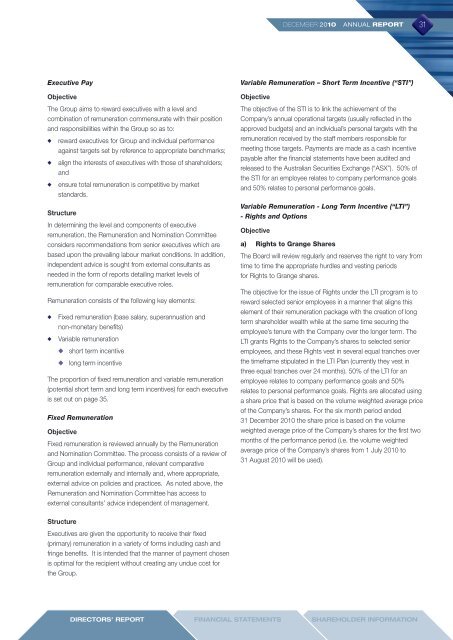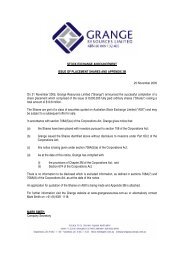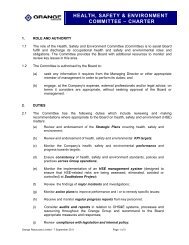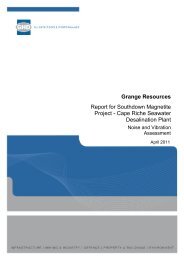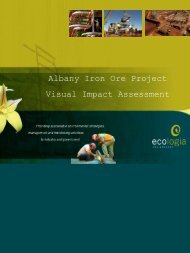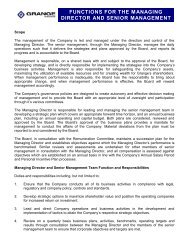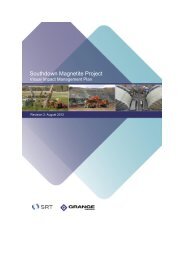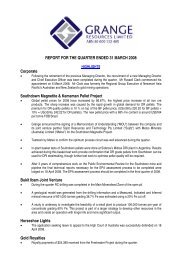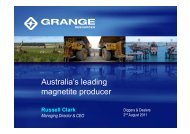2010 Annual Report - Grange Resources
2010 Annual Report - Grange Resources
2010 Annual Report - Grange Resources
Create successful ePaper yourself
Turn your PDF publications into a flip-book with our unique Google optimized e-Paper software.
DECEMBER <strong>2010</strong> ANNUAL REPORT 31<br />
Executive Pay<br />
Objective<br />
The Group aims to reward executives with a level and<br />
combination of remuneration commensurate with their position<br />
and responsibilities within the Group so as to:<br />
◆ ◆ reward executives for Group and individual performance<br />
against targets set by reference to appropriate benchmarks;<br />
◆ ◆ align the interests of executives with those of shareholders;<br />
and<br />
◆ ◆ ensure total remuneration is competitive by market<br />
standards.<br />
Structure<br />
In determining the level and components of executive<br />
remuneration, the Remuneration and Nomination Committee<br />
considers recommendations from senior executives which are<br />
based upon the prevailing labour market conditions. In addition,<br />
independent advice is sought from external consultants as<br />
needed in the form of reports detailing market levels of<br />
remuneration for comparable executive roles.<br />
Remuneration consists of the following key elements:<br />
◆ ◆ Fixed remuneration (base salary, superannuation and<br />
non-monetary benefits)<br />
◆ ◆ Variable remuneration<br />
◆ ◆ short term incentive<br />
◆ ◆ long term incentive<br />
The proportion of fixed remuneration and variable remuneration<br />
(potential short term and long term incentives) for each executive<br />
is set out on page 35.<br />
Fixed Remuneration<br />
Objective<br />
Fixed remuneration is reviewed annually by the Remuneration<br />
and Nomination Committee. The process consists of a review of<br />
Group and individual performance, relevant comparative<br />
remuneration externally and internally and, where appropriate,<br />
external advice on policies and practices. As noted above, the<br />
Remuneration and Nomination Committee has access to<br />
external consultants’ advice independent of management.<br />
Variable Remuneration – Short Term Incentive (“STI”)<br />
Objective<br />
The objective of the STI is to link the achievement of the<br />
Company’s annual operational targets (usually reflected in the<br />
approved budgets) and an individual’s personal targets with the<br />
remuneration received by the staff members responsible for<br />
meeting those targets. Payments are made as a cash incentive<br />
payable after the financial statements have been audited and<br />
released to the Australian Securities Exchange (“ASX”). 50% of<br />
the STI for an employee relates to company performance goals<br />
and 50% relates to personal performance goals.<br />
Variable Remuneration - Long Term Incentive (“LTI”)<br />
- Rights and Options<br />
Objective<br />
a) Rights to <strong>Grange</strong> Shares<br />
The Board will review regularly and reserves the right to vary from<br />
time to time the appropriate hurdles and vesting periods<br />
for Rights to <strong>Grange</strong> shares.<br />
The objective for the issue of Rights under the LTI program is to<br />
reward selected senior employees in a manner that aligns this<br />
element of their remuneration package with the creation of long<br />
term shareholder wealth while at the same time securing the<br />
employee’s tenure with the Company over the longer term. The<br />
LTI grants Rights to the Company’s shares to selected senior<br />
employees, and these Rights vest in several equal tranches over<br />
the timeframe stipulated in the LTI Plan (currently they vest in<br />
three equal tranches over 24 months). 50% of the LTI for an<br />
employee relates to company performance goals and 50%<br />
relates to personal performance goals. Rights are allocated using<br />
a share price that is based on the volume weighted average price<br />
of the Company’s shares. For the six month period ended<br />
31 December <strong>2010</strong> the share price is based on the volume<br />
weighted average price of the Company’s shares for the first two<br />
months of the performance period (i.e. the volume weighted<br />
average price of the Company’s shares from 1 July <strong>2010</strong> to<br />
31 August <strong>2010</strong> will be used).<br />
Structure<br />
Executives are given the opportunity to receive their fixed<br />
(primary) remuneration in a variety of forms including cash and<br />
fringe benefits. It is intended that the manner of payment chosen<br />
is optimal for the recipient without creating any undue cost for<br />
the Group.<br />
DirectorS’ <strong>Report</strong><br />
Financial Statements<br />
Shareholder information


